In Greco-Roman mythology, Leuce, also spelled Leuke, was a nymph and a daughter of the Titan Oceanus.

Populus is a genus of 25–30 species of deciduous flowering plants in the family Salicaceae, native to most of the Northern Hemisphere. English names variously applied to different species include poplar, aspen, and cottonwood.

Liriodendron is a genus of two species of characteristically large trees, deciduous over most of their populations, in the magnolia family (Magnoliaceae).
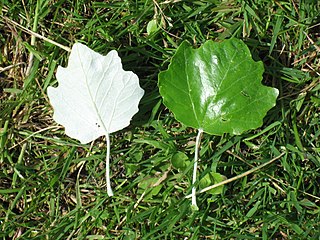
Populus section Populus, of the Populus (poplar) genus, includes the aspen trees and the white poplar Populus alba. The five typical aspens are all native to cold regions with cool summers, in the north of the Northern Hemisphere, extending south at high altitudes in the mountains. The White Poplar, by contrast, is native to warmer regions, with hot, dry summers. These trees are all medium-sized deciduous trees ranging 15–30 metres (49–98 ft) tall.
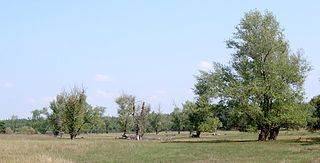
Populus nigra, the black poplar, is a species of cottonwood poplar, the type species of section Aigeiros of the genus Populus, native to Europe, southwest and central Asia, and northwest Africa.
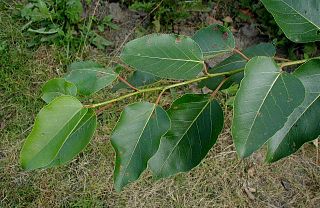
The balsam poplars are a group of about 10 species of poplars, indigenous to North America and eastern Asia, distinguished by the balsam scent of their buds, the whitish undersides of their leaves, and the leaf petiole being round in cross-section. They are large deciduous trees, 30–60 m tall, with leaves with a rounded base, pointed apex, and a whitish waxy coating on the underside of the leaf; this latter distinguishes them from most other poplars. The name is derived from the pleasant balsam smell of the opening buds and leaves in spring, produced by a sticky gum on the buds which also helps protect the buds from insect damage. The balsam poplars are light-demanding trees that require considerable moisture. Balsam poplars are tolerant of very cold conditions, occurring further north than other poplars except for the aspens. The poplars in Southern California are tolerant of 100 plus degree heat. They grow along dry washes and dry riverbed's. The dry washes and dry riverbeds will have flowing water when it rains sufficiently. Their leaves hang down and are at an edge to the sun. This may be another factor why they can take the high heat. Their leaves tremble in the slightest breeze like the quaking aspen
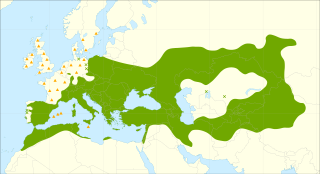
Populus alba, commonly called silver poplar, silverleaf poplar, or white poplar, is a species of poplar, most closely related to the aspens. It is native to Morocco and then Portugal through central Europe to central Asia. It grows in moist sites, often by watersides, in regions with hot summers and cold to mild winters.
White poplar is a common name used to refer to several trees in the genus Populus, including:
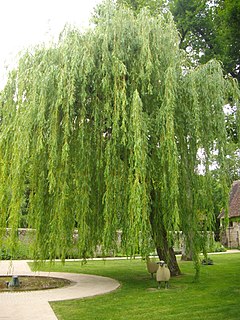
Salix babylonica is a species of willow native to dry areas of northern China, but cultivated for millennia elsewhere in Asia, being traded along the Silk Road to southwest Asia and Europe.
Reply to Li Shuyi is a poem written on May 11, 1957 by Mao Zedong to Li Shuyi, a friend of Mao's first wife Yang Kaihui and the widow of the executed Communist leader Liu Zhixun. In the poem, "poplar" refers to Yang Kaihui, whose surname Yang means "poplar", and who also had been executed; and "willow" is the literal meaning of Liu's surname. Wu Gang is a man who, according to Chinese legend, lives on the moon, and was forced by the gods to fell a laurel tree forever.

Davie Poplar is a large tulip poplar tree located in McCorkle Place on the campus of the University of North Carolina at Chapel Hill. Named in honor of Revolutionary War general and university founder William Richardson Davie, the tree is approximately 300 to 375 years old.

Manlleu is municipality in the comarca of Osona, in the province of Barcelona, Catalonia, northern Spain.

Populus balsamifera, commonly called balsam poplar, bam, bamtree, eastern balsam-poplar, hackmatack, tacamahac poplar, tacamahaca, is a tree species in the balsam poplar species group in the poplar genus, Populus. The genus name Populus is from the Latin for poplar, and the specific epithet balsamifera from Latin for "balsam-bearing".

The Poplars series paintings were made by Claude Monet in the summer and fall of 1891. The trees were in a marsh along the banks of the Epte River a few kilometers upstream from Monet's home and studio. To reach his floating painting studio that was moored in a place he went by small boat up the nearby waterway to where it joined the mainstream. The trees were along the riverside in single file, following along an S-curve. There were three groups of paintings — in one group the paintings have towering Poplars that go off the top edge of the canvas, in another group, there are seven trees and in another group three or four Poplars on the banks of the Epte River near Giverny. The trees, which actually belonged to the commune of Limetz, were put up for auction before Monet had completed all of his paintings. At a certain point, Monet was forced into buying the trees because he still wasn't finished with his paintings. After he finished the series he sold the trees back to the lumber merchant who wanted them.
Siyang County is under the administration of Suqian, Jiangsu province, China. It borders the prefecture-level city of Huai'an to the southeast.

Populus ciliata, the Himalayan poplar, is a large deciduous tree with tall clean straight trunk and wide rounded crown. The bark of the young trees is smooth greenish-grey and the bark of the old trees is dark brown with vertical cracks. Leaves are broadly ovate with serrulate-crenate and hairy margins. Flowers are drooping raceme catkins appear before or with leaves. Populus ciliata flowers are dioecious, individual flowers are either male or female. Perianth of male flowers is bell-shaped and female flowers are bluntly toothed. Their capsule encloses an average of 100–150 seeds, which are covered by long silky hair.

Populus euphratica, commonly known as the Euphrates poplar, desert poplar, diversiform-leaved poplar, or poplar diversifolia, is a species of poplar tree in the willow family.

A genetically modified tree is a tree whose DNA has been modified using genetic engineering techniques. In most cases the aim is to introduce a novel trait to the plant which does not occur naturally within the species. Examples include resistance to certain pests, diseases, environmental conditions, and herbicide tolerance, or the alteration of lignin levels in order to reduce pulping costs.














